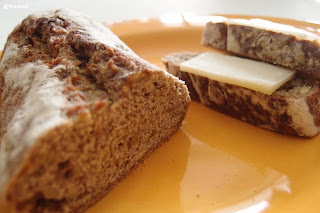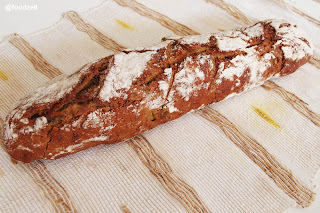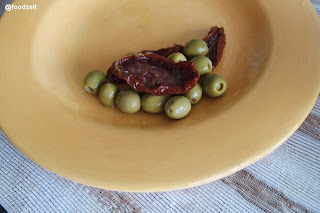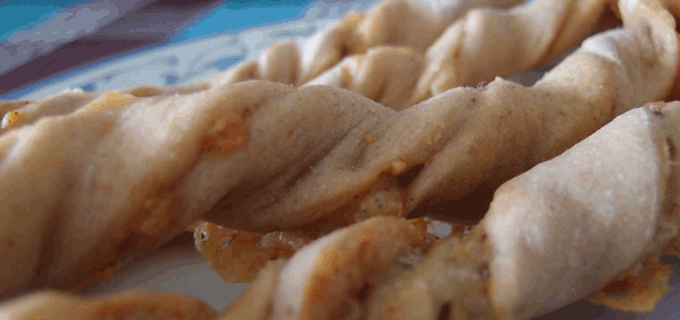 |
| bread crumb view with slice of bread with cheese topping |
 |
| Fresh baked bread right out of the oven |
- 160 g whole wheat flour
- 160 g water
- 16 g starter
Scald
- 60 g pumpkin seeds
- 40 g crushed walnuts
- 2 teaspoon cumin
- 1 teaspoon star anise seeds
- 1 clove of garlic
- 14 g salt
- 1 teaspoon turmeric
- 100 g boiling water
Main dough
- Wheat sourdough
- Scald
- Olives
- 400 g whole wheat flour
- 185 g yoghurt
- 4 g fresh yeast
- 50 g stuffed green olives
- 50 g sundried tomatoes
 |
| Olives and sun dried tomato ready for the bread |
 |
| My fermentation basket provisorium |
If you don’t have one like me, just pop them in a bowl. Cover everything up and put it aside for another 60 minutes (use the finger probing method to check if the dough is ready and fermented). Once the breads have been fermented, I drop them upside down from their bread baskets on my permanent Teflon baking foil on which I already sprinkled a bed of flour. Also sprinkle a layer of flour on top of the bread before putting in the oven.
The oven should be pre heated on 250°C. Now pour a cup of hot water in the oven (if you do not have this inbuilt steaming program in your oven at home), pop the bread in the oven and also place a cup of water on the floor of the oven to give some additional steam later on. Quickly close the door so the hot steam will be caught within the oven. Having all that steam in the oven is, like mentioned many times before, extremely important for a scrumptious crust and a great consistency of the bread.
Bake the breads for 10 - 15 minutes like this until it reached the right brown color that you are looking for in a bread crust, then open up the door, let the steam out, lower the heat on 190°C and continue to bake the bread for another 30 - 35 minutes, if you have 2 flat or long shaped breads like me, 35 – 40 minutes if you have one bigger bread. After baking, knock on the bottom of the bread to listen if it sounds hallow, if so, then your bread should be ready, if not, bake it for another 5 – 10 minutes. Now take it out and cover it up and put it to rest and slowly cool in a warm place before cutting a first piece of it.
The olive bread is already half gone (day 1) and I have to say that it is a full success. The only thing missing is some Tsatsiki. If I would have some, I think the whole bread would be gone already. I have to go out later and see if I can find sour cream and yogurt to make Tsatsiki (which is not always evident here)
Sauerteig
- 160 g Weizenvollkornmehl
- 160 g Wasser
- 16 g Weizenanstellgut
Alles gut verrühren und wie immer an einem warmen Platz für 16 Stunden gehen lassen.
Bruchstück
- 60 g Kürbis samen
- 40 g Walnusssplitter
- 2 TL Kreuz Kümmel
- 1 TL Stern Anis Samen
- 1 Knoblauch Zehe
- 14 g Salz
- 1 TL Gelbwurz Pulver
- 100 g kochendes Wasser
Hauptteig
- Sauerteig
- Quellstück
- Oliven
- 400 g Weizenmehl 550
- 185 g Joghurt
- 4 g frische Hefe
- 50 g entkernte Oliven (besser schwarz damit der Kontrast zum Brot besser rauskommt, hatte ich aber nicht also geht auch grünen)
- 50 g sonnengetrocknete Tomaten
Oliven und Tomaten Flüssigkeit ablassen und im Küchenpapier trocknen. Alle Zutaten in die Küchenmaschine geben und 6 Minuten kneten. Danach erfolgt eine Teigruhe von 30 Minuten. Dann die Oliven zugeben und von Hand dazugeben und darauf achten dass diese nicht zerquetscht werden. Jetzt den Teig strecken und falten. Teig falten: den Teig zu einem Quadrat drücken und von allen Ecken in die Mitte zusammenfalten. Danach wieder eine Teigruhe von 30 Minuten einhalten. Noch einmal falten und dann schließt sich eine Teigruhe von 60 Minuten an. Jetzt den Teig rund wirken und probieren die Oliven in der Mitte sind und nicht zu viele am Rand rausschauen. Dann das Brot in ein gut bemehltes Garkörbchen geben, mit einer Abdeckfolie abdecken und nochmals 60 Minuten zur gare stellen. Anschließend mit der Fingermethode probieren ob der Teig schon genug gegangen ist (mehr dazu bald hier). Wenn das Brot fertig ist, dann nehme ich den Gar Korb und stülpe das Brot auf mein permanentes Backpapier aus Teflon (Einschießer / Backstein u.a. geht auch). Dann kommt noch mal ein Sprinkler Mehl darauf und man kann jetzt das Brot nach Belieben einschneiden.
Dann wird das Ganze in den auf 250°C vorgeheizten Ofen eingeschoben. Dann sollte das Brot eingeschwadet werden. Wenn der Ofen keine solche Funktion hat schüttet man dazu einfach Wasser auf den Boden des Ofens oder in ein vorgeheiztes Backblech auf dem Boden des Ofens. Dann schnell die Ofentüren schließen damit die Schwaden im Ofen verbleiben. Diese bilden dann die Kruste. So wird das Brot nun für 10 – 15 Minuten gebacken bis die gewünschte Bräune der Kruste erreich ist. Dann wir der Ofen geöffnet, der Dampf wird abgelassen und die Türe wieder geschlossen und die Temperatur auf 190 Grad heruntergestellt. Danach wird das Brot für weitere 30 – 35 (kleine / längliche / flache Brote wie bei mir) oder 40 – 45 Minuten (größere Brote) gebacken. Nach dem Backen immer von unten mit den Knöcheln auf das Brot klopfen und hören ob es in der Mitte schon durch ist, wenn es innen hohl klingt, ist das der Fall. Wenn nicht, dann backen wir es noch für weitere 5 – 10 Minuten weiter. Wenn das Brot fertig ist, aus dem Ofen nehmen und abgedeckt für ein paar Stunden an einem warmen Platz auskühlen lassen. Dann kann man es anschneiden und genießen.
Das Brot ist jetzt schon halb gegessen (am 1. Tag) und ich muss sagen, wenn ich jetzt noch Tsatsiki hätte, dann wär der Schlemmerschmaus perfekt und wahrscheinlich nichts mehr vom Brot übrig. Muss nachher mal schauen ob ich noch Quark für den Tsatsiki finde.
Like always, I will try to post this self made bread to the yeast spotting webpage like every time I am baking one as I thing this awesome blog event always deserves my support











This bread looks fantastic. I'll have to give it a try!!
ReplyDeletePete, Please do and let me know how it went. The bread should be amazing with your Moroccan Inspired Grilled Chicken Wings that look just awesome
ReplyDeleteVery nice bread, and the pre-drying of the olives really makes them more manageable.
ReplyDeleteYou are very adventurous with your seasoning, but obviously it worked.
Happy Baking,
Karin
Yes, the drying trick from you really was a great idea and the bread, maybe also because of the spices, was a complete winner.
DeleteI think since I move to Asia, I am just more adventurous with spices, you should give it a try once.
MIt den Gewürzen bestimmt sehr außergewöhnlich- das hab ich bis jetzt noch nicht geschafft, so würzige Brote zu backen. Und gut aussehen tuts noch dazu....
ReplyDeleteJa, wie oben gesagt, unbedingt mal ausprobieren. Wir Schwaben backen immer Brote und tunken die dann in würzige Soßen um da Geschmack reinzubringen. Ich finde Gewürze im Bort ist so was ähnliches, da baut man des Sössle schon ins Brot mit ein. Also ich finde, unbedingt probieren. Auf meiner Brot Gewürz Liste stehen bisher:
DeleteAnise
Basil
Bread spice
Cardamom
Chives
Cloves
Cumin
Curry
Coriander
Dill
Fennel
Horseradish
Mustard
Nutmeg / mace
Oregano
Paprika
Pepper
Pimento
Rosemary
Spring onion
Vanilla
Wasabi
Da kann man ne Brot Weltreise mit mache.
Das mach ich dann mal wenn ich weniger kritikfreudige Mitesser hab... und meistens brauch ich einen "Allrounder" als Brot, das zu Marmelade oder Honig genausogut paßt wie zu Leberwurst. Na, es wird sich alles finden - und Gewürze liebe ich ja ohne Ende.
DeleteSchönen Sonntag!
Das geht mir ähnlich, ich backe auch meistens Brote, die man mit Marmelade oder Aufschnitt essen kann. Ich benutze allerdings viel die typischen Brotgewürze wie Anis, Fenchel, Kümmel und Koriander.
DeleteVielen Amerikanern erscheint das merkwürdig, sein Brot überhaupt zu würzen, amerikanische Brote sind eher leicht süsslich.
Rosmarin nehme ich für Peter Reinhart's Kartoffel-Rosmarin-Vollkornweizenbrot (sehr lecker)
Senf habe ich auch schon verwendet: http://hanseata.blogspot.com/2013/02/senfbrot-german-mustard-bread.html)
Schabzigerklee (extra aus Deutschland importiert) für Vinschger Paarlen: http://www.thefreshloaf.com/node/18284/vinschgauer-bread-unique-alpine-flavor
Brennessel: http://www.thefreshloaf.com/node/21966/faye039s-award-winning-nettle-bread
Meine saisonalen Brote sind auch mit "Kuchengewürzen" abgeschmeckt:
Zimt und Ingwer in Kürbisbrot (http://hanseata.blogspot.com/2010/10/german-pumpkin-bread.html)
Piment und Muskatnuss in Thanksgiving Bread (http://www.kingarthurflour.com/recipes/new-england-thanksgiving-bread-recipe)
Orangenblütenwasser in Pan de Muerto (http://brotandbreaddeutsch.blogspot.com/2012/11/pan-de-muerto-totenbrot.html)
Wenn ich es richtig bedenke, bin ich doch abenteuerlicher, als ich dachte!
Das Brot das ich in meiner kurzen Zeit in Amerika (8 Monate) erleben durfte, war nicht so der Kracher. Hundert verschiedene Sorten, eines labbriger als das andere, alle keine Kruste, zu süße und geschmeckt hat’s mir einfach nicht. Vielleicht lag’s dran dass ich nur in NY war? Da hätte ich früher oder später auch schon das Backen angefangen.
DeleteJa, da stimme ich mit Dir überein, wenn ich die Liste so ansehe, dann ist das alles andere als nicht abenteuerlustig . Weiter so. Ich bin mal gespannt wenn es eine BBD Aktion mit Gewürzen gibt. Gab es das schon?
Nee, leider ist diese Brotmisere landesweit. Es gibt nur sehr vereinzelt gute Bäckereien, etwa in San Francisco, ansonsten ist es genauso wie du es erlebt hast. Die Schlabberbrote haben mich ja schliesslich auch zum Brotbacken veranlasst, weil ich mich damit nicht abfinden konnte.
DeleteWas ist BBD?
Ja, wir sind da in einer ähnlichen Situation. Das mit dem Brot hier ist auch nicht so richtig geregelt obwohl es auch hier schon die ersten Expat Bäcker gibt (der Preis ist allerdings auch jenseits von Gut und Boese, da backt man schon lieber selber).
ReplyDeleteBBD ist Bread Baking Day. Kennst Du doch, von Zora. Das sollte man mal einen Gewürzbrot Tag veranstalten :)